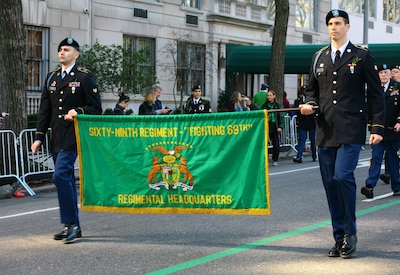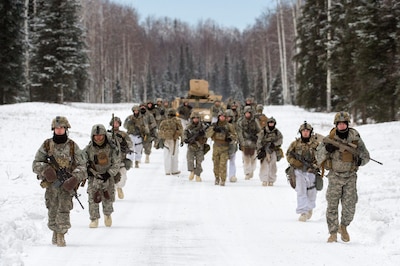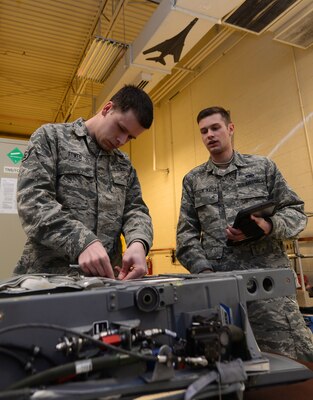By Army Col. Richard Goldenberg New York National Guard
ALBANY, New York, March 14, 2018 — More than 800 New York
Army National Guardsmen from the 1st Battalion, 69th Infantry Regiment, will
lead the world’s largest St. Patrick’s Day Parade for the 167th time on March
17.
The battalion, known as the "Fighting 69th," was
originally organized as a militia unit for Irish immigrants. In 1851, the
battalion was asked to lead the annual parade of Irish Catholics in case of
anti-immigrant violence.
The battalion has had this honor ever since, celebrating its
Irish-American heritage.
The unit was dubbed “that fighting 69th Regiment” by
Confederate army Gen. Robert E. Lee, after he witnessed their charge at the
Battle of Fredericksburg in 1862.
The unit's soldiers further distinguished themselves in
World War I, World War II, and during combat deployments to Iraq and
Afghanistan.
Reflection of the Community
While today’s 69th Infantry Regiment is no longer the
Irish-only unit of a century ago, it remains a reflection of New York City’s
immigrant community, said Army Lt. Col. Don Makay, commander of the 1st
Battalion.
“The [unit] … continues to reflect the immigrant nature of
the city,” he said, “although that immigrant is no longer just Irish, but from
many different countries.”
“For the 69th, the day doesn't necessarily instill pride in
being Irish, as many of our soldiers aren't Irish. It instills the pride in
being a New Yorker, an American, and a soldier,” Makay said. “Something the
Irish started with the regiment, but has since been carried on by many
nationalities.”
This year the unit will host Army Lt. Gen. Daniel Hokanson,
the vice chief of the National Guard Bureau, and mark the unit’s centennial of
service in World War I as part of the 42nd Infantry Division in France.
Douglas MacArthur, at the time a brigadier general
commanding the 84th Brigade with regiments from Alabama and Iowa, said of the
regiment’s actions after a particularly arduous battle: "By God, it takes
the Irish when you want a hard thing done!”
Traditions
A host of traditions surround the 69th and the St. Patrick's
Day parade.
Members of the 69th place a sprig of boxwood on their
uniform as a reminder of the regiment's charge against Confederate lines at
Marye's Heights in Virginia at the Battle of Fredericksburg, Dec. 13, 1862.
To mark their Irish heritage, the men of the Union Irish
Brigade, including the 69th Regiment, put sprigs of boxwood in their hatbands.
The Union attack failed, but the burial details found that
the Union troops who made it closest to the enemy fortifications before being
killed had sprigs of boxwood in their hats.
Officers of the 69th carry a fighting stick made of
blackthorn wood imported from Ireland. The sticks, much like a British
officer's swagger stick, are considered the mark of an Irish leader and
gentleman.
The soldiers are accompanied on their march by two Irish
Wolfhounds, the official mascot of the 69th Infantry. The dogs are
representative of the regimental motto, "gentle when stroked, fierce when
provoked" and will be led this year by Sgt. Quentin Davis and Spc. Ilya
Titov, the battalion’s noncommissioned and soldier of the year, respectively.
For the officers of the 69th the day begins at 6 a.m. in the
commander's office, a room lined with relics dating back to the Civil War. The
traditions of the boxwood and the blackthorn sticks are explained to new
officers, along with a look at the "Kilmer Crucifix."
The religious icon was once worn by poet Joyce Kilmer -- the
author of the poem "Trees" -- who died while serving in the 69th in
World War I. Today it is handed down from battalion commander to battalion
commander.
These mementos of the unit’s Irish lineage and the lead role
in the city parade are meant to inspire a new generation of immigrant
citizen-soldiers, Makay explained.
Ready to Defend
“I imagine the value of seeing this unit march is a reminder
that the old values of opportunity, freedom, [and] equality are still alive and
represented in the “Fighting 69th” and U.S. military,” Makay said. “The
soldiers marching in the parade remind [us] all of a time when the Irish risked
it all, sailed here, helped build a city, formed the 69th, and that regiment
has fought for the same values from the Civil War to the War on Terrorism.”
“The parade is always a chance to show people, "Yes, we
are still here, and still ready to defend," he said.
At 7 a.m., the regiment's honorary bag piper leads the men
out of the Lexington Avenue and over to 51st Street for a special mass at St.
Patrick's Cathedral.
Following mass, the battalion marches to 44th Street and 5th
Avenue, the official start of the parade.
The battalion is joined by its support company from the
427th Brigade Support Battalion, the 42nd Infantry Division Band, and numerous
guests of the regiment from the unit’s higher headquarters, including the 27th
Infantry Brigade Combat Team and 42nd Infantry Division, two other notable Army
formations of World War I fame.
The march formation also includes members of the Veterans
Corps of the 69th. The corps, comprised of former members of the 69th, helps
preserve the history of the regiment and foster camaraderie, morale and welfare
of the 69th's soldiers and families.
The parade is also joined by volunteers from the Irish
Defense Forces’ 58th Reserve Infantry Battalion, who travel to New York at
their own expense to share in the celebration with the battalion.
It takes an hour for the soldiers to march up 5th Avenue to
the end of the parade route, where a special subway train picks them up and
transports them back downtown to the East Village.
This year’s unit awards and recognition ceremony will be
held at the Great Hall of The Cooper Union, a similarly historic part of New
York City, which opened in 1858.
“I say to the soldiers-- take pride in the history of this
great unit, which has always stood for fighting for something bigger than
yourself,” Makay said of the parade and celebration of the unit’s Irish roots.
“Take pride in what it means to be a 69th soldier -- to be tough, fit and ready
to fight and protect what's important.”
Makay noted that after nearly 170 years of service, the
commitment of soldiers to serve and train to defend their neighbors and their
nation has not changed.
“Many of the men that marched in the first St. Patrick's
Parade with the 69th went off to defend the Union less than a decade later,” he
said. “The men and women who march this Saturday are of the same level of
commitment, should they be called, and will serve and fight accordingly.”










